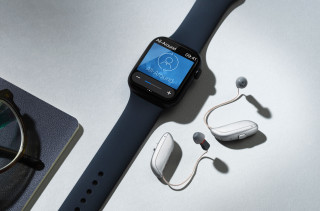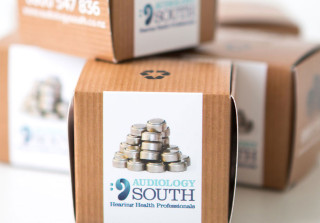
Hearing Aid DIY
Repairs and servicing at home.
Hearing Aid Batteries
How do they work?
Modern hearing devices typically use Zinc Air batteries which have tiny holes on the top surface. Once the sticker is removed from the battery, air causes a chemical reaction producing zinc oxide which in turn creates energy. Once this has been removed, the battery will start to discharge, and this process cannot be stopped. Only remove the sticker from a battery minutes before you are ready to use it.
Battery Type and Life
There are four common sizes of hearing aid battery which are colour coded to make it easier to purchase, from the largest 675 size (coloured blue) to the common 13 (orange) or 312 (brown) size and the smallest size 10 (coloured yellow). The size of battery will depend on the type of hearing instruments you use and their power requirements. For example, larger, more powerful behind the ear (BTE) devices typically use size 13 or 675 cells, while smaller, in the ear (ITE) or canal (CIC) styles will use size 312 or 10.
Battery life will depend on many variables including the size of battery, your degree of hearing loss and therefore power requirements of the hearing instrument. The number of hours you use your devices, the amount of sound they are processing and how much streaming (e.g. via Bluetooth technology) you like to do per day all have a significant impact on battery life. Battery life can vary as much as several days for the smaller size 10 and 312 to as many as 14 to 21 days for the larger 675 size.
Battery Storage and Recycling

Batteries should be kept out of the sun and very cool environments. The ideal storage is room temperature between 10 and 25OC. Hearing aid batteries are very safe but, there are some precautions that should be taken when storing. Button cell batteries must be kept out of reach of children and pets as they can cause serious health issues if swallowed.
Audiology South strongly encourages you to recycle your hearing aid batteries rather than disposing of them in your household rubbish. We’ve made this easy by providing battery recycling boxes and designating our clinics as drop-off recycling points.
As a final word, many companies now have rechargable hearing aids on the market which do away with the need to change batteries and are kinder on our environment! They’re also great for people who struggle to change batteries because of eyesight or dexterity issues. Because of this convenience we see a future where most hearing aids are likely to use this as a default power option!
Hearing aid apps and how to troubleshoot
We like to send you out of the clinic with your hearing aids and smart phone communicating together but sometimes things stop working. Your smart phone software upgrades and updates can disrupt the pairing we do for you in clinic. If this happens, try these steps or, call in to see our friendly team for assistance, tips and advice.
- Has Bluetooth been disabled on your phone? Turn Bluetooth on, exit the app, wait a few secs then go back.
- If your hearing aids are still not connecting and Bluetooth is active, open and close the hearing aid battery doors. This puts the aids into “discovery mode” so the app can find them again.
- Still not working? Reset everything by turning off both the phone and aids, and in close proximity turn them back on.
When all else fails:
- Check your manufacturer’s instruction book that came with your hearing aids. It normally has a step-by-step guide on connecting/pairing hearing aids.
- Call in to see us for help and support.
- Check on the web including YouTube link as most brands have excellent guides that walk you through the process.
- Consider updating your handset but talk with us first as we can give guidance on which phone might work best with your brand and model of hearing aids.
Hearing Aid Troubleshooting
Troubleshooting hearing aids is relatively straight forward, please consult your instruction booklet provided when you purchased your hearing aids. If this cannot be located here are some common things you could try at home:
No/little sound output:
- Replace your battery or try turning your instruments off and on.
- Check the sound outlet for wax & dirt. If your hearing aids use filters, try changing these.
- Moisture could be in the tubing or sound outlet. Check to see if these are blocked and either replace or put in a dry aid kit.
Constant feedback/whistling
- Check the fitting of the hearing aid and ensure correct insertion.
- Check the volume has not been turned up too high.
- Wax build up in the ear canal- this will need to be removed by a ear health professional - please contact us for advice.
Distorted sound quality
- Microphone of hearing aid may be blocked- try brushing this area clean.
- Sound outlet may be blocked - try cleaning and if your hearing instrument uses filters try changing these.
- Hearing aid may have switched to incorrect setting or volume - try resetting by switching off/ on or re-set using your smartphone app.
Moisture
Most modern hearing aids are water resistant, so you don’t need to worry about being caught in a rain shower, doing some exercise or an occasional splash while gardening.
Warmer days can mean more perspiration just as cooler days can add condensation which can lead to moisture building up inside your hearing aids. Moisture build up damages hearing aids and is a major reason they are returned for repairs. We recommend you store your hearing aids in a dry aid kit on a nightly basis. At bedtime, open the battery drawer so the aids are switched off and place them in the container. Check the colour of the drying capsule – when it changes from orange to white it needs to be changed.
If you are prone to excess moisture build up, a good investment could be a hearing aid dehumidifier or dryer. Dehumidifiers are relatively inexpensive and can add years of life to your hearing aids.


Preventing Long-term Damage
- Remove your aids before showering, swimming, or water sports such as water-skiing, boating, or surfing.
- Do not leave your aids in direct sunlight or extreme heat in humid conditions (for example, on the dashboard or in the glove box of your car, or on the window ledge in the bathroom).
- Should you need to remove your hearing aids, store them (and batteries) in a dry, safe place such as in their protective case.
- Take care when using hairspray, hair products, sunscreens and insect repellent. Make sure products have dried before putting your aids in.
- Wipe your hands before touching your aids to avoid dirt getting into sensitive microphones.
If your aids do get wet
- Do not use a hair dryer to dry them.
- Remove the battery and leave the drawer open to dry out for a few hours.
- If you have a hearing aid dry kit, dehumidifier, or hot water cupboard place your aids into them as soon as possible.
If your aids have had ample time to dry, but you find that they cut out when noises are loud, or turn off and on, or that sounds are distorted or fade, or you hear a lot of static, first, replace the batteries, but if that doesn’t solve the problem contact our team or bring them in for repair.